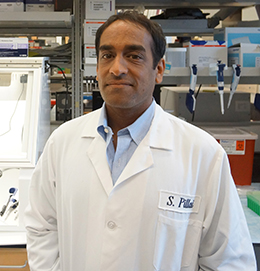Over the past few months, we’ve reported on work by amfAR grantees charting the diversity of cell types capable of maintaining HIV in a latent state, protected from standard attack by the immune system. All such reservoirs, from T cell subsets to specialized cells in the vagina and brain, are potential impediments to achieving a cure for HIV.
 Dr. Satish PillaiIn a new paper published in PLoS Pathogens, Dr. Satish Pillai of the amfAR Institute for HIV Cure Research, with colleagues from various institutions, describes how a component found in all cells contributes to establishing such latency, and how it appears to offer a specific new target for therapeutic intervention.
Dr. Satish PillaiIn a new paper published in PLoS Pathogens, Dr. Satish Pillai of the amfAR Institute for HIV Cure Research, with colleagues from various institutions, describes how a component found in all cells contributes to establishing such latency, and how it appears to offer a specific new target for therapeutic intervention.
Pillai and colleagues began their study with the recognition that current drugs used to drive HIV from a dormant state—so-called latency reversing agents, or LRAs—are inadequate. Their potency is low, and they’ve had little impact on reducing the number of HIV-infected cells in clinical trials.
So Pillai began “fishing,” using sophisticated screening techniques based on CRISPR gene editing to search for unexpected processes that might be involved in the regulation of HIV in latently infected cells. They found one: the proteasome.
Proteasomes are structures found within normal cells that digest unneeded or damaged proteins. Several drugs that inhibit proteasomes have been approved by the FDA as cancer therapies. Two such drugs, bortezomib and carfilzomib, strongly enhanced the ability of existing LRAs to activate virus from the cellular reservoirs of HIV-infected individuals. They had the added benefit of limiting known side effects of LRAs such as activating the cells and expanding the reservoir by cellular division.
The researchers concluded that their findings provide “a new avenue to expose latent HIV,” and thus bring us one step closer to an ultimate cure for HIV.
Dr. Laurence is amfAR’s senior scientific consultant.